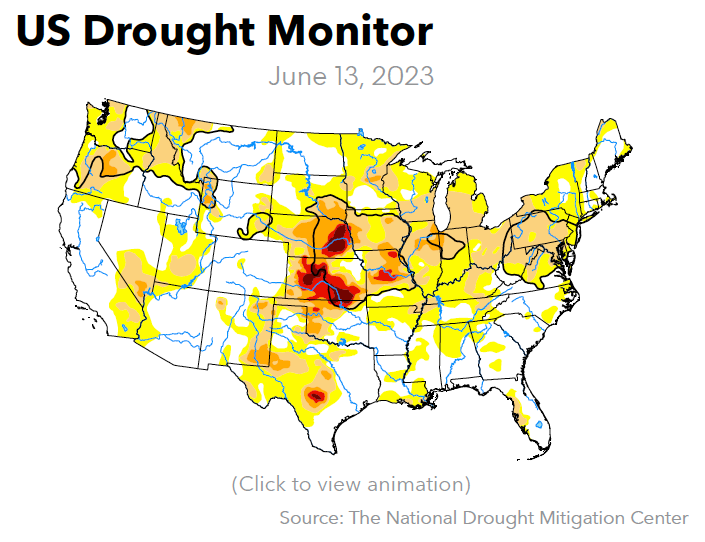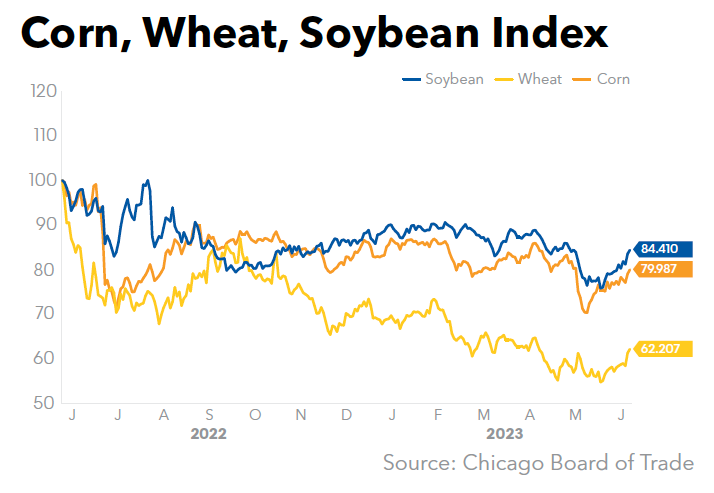Eastern
Cornbelt:
After a cool and rainy start to the week,
temperatures in central and northern Illinois climbed to the upper-80s on June
15-16, with an increased chance of thunderstorms by the weekend.
Temperatures in the 80s were also reported
across central Indiana late in the week, while highs topped out in the low- to
mid-70s across northern Ohio. Cool temperatures and spotty showers were common
across Michigan’s lower peninsula as well.
The corn crop was 93-97% emerged in the Eastern Cornbelt and 89% emerged in Michigan by June 11, with good or excellent ratings assigned to 57% of the acreage in Ohio, 55% in Indiana, 48% in Illinois, and 38% in Michigan. The regional soybean crop was 97-98% planted and 83-92% emerged by that date.
Western
Cornbelt:
High heat returned to much of the Western
Cornbelt during the week, along with a smoky haze from Canadian wildfires.
Highs in the 80s and 90s were reported across Iowa and Nebraska as the week
progressed, with an increased chance of scattered showers and thunderstorms by
the weekend.
The Southeast was hit with severe weather on
June 14-15, with at least 10 tornadoes reported in Texas, Alabama, and Georgia,
along with heavy rain and flooding in some locations. Albany, Ga., reportedly
received more than seven inches of rain over a 24-hour period.
USDA reported that 97-98% of the regional
corn crop was emerged by June 11, with good or excellent ratings assigned to
70% of the acreage in Iowa, 61% in Nebraska, and 47% in Missouri. The regional
soybean crop was 93-100% planted and 86-95% emerged, while cotton planting had
progressed to 97% complete in Missouri.
California:
Fertilizer movement in California remained
steady in mid-June as the state’s remarkable drought recovery continues. “We
are still in-season with strong demand,” said one regional contact.
Most of California was drought-free as of
June 15, with only a small patch of abnormally dry conditions along the
northern edge of the state, and one larger section of abnormally
dry-to-moderate drought reported in the Southern California interior.
The state’s drought-stricken reservoirs have
rebounded following the extraordinarily wet winter. Lake Oroville is now at
100% of total capacity after rising more than 240 feet since Dec. 1, 2022, and
is presently at 127% of average capacity for this time of year. Shasta Lake,
the largest in the state and the most important for the Central Valley, is at
97% of capacity.
Pacific Northwest:
Cool, wet weather settled over much of the
Pacific Northwest in mid-June, with highs staying in the 70s. Forecasts warned
that temperatures could drop low enough to bring snow to some of Oregon and
Washington’s high Cascade peaks during the week.
Gusty winds prompted red flag fire warnings
for parts of southeastern Washington and Oregon at midweek, with winds up to 35
mph and relative humidity dropping in to the 20% range.
The planting of spring wheat and barley,
though delayed in May by wet conditions, had progressed to 98% complete in
Montana, 99% in Idaho, and 100% in Washington by June 11. Winter wheat rated as
good or excellent totaled 55% of the acreage in Washington, 52% in Idaho, 45%
in Montana, and just 30% in Oregon.
Western Canada:
Dry, hot weather blanketed much of
Saskatchewan and Manitoba during the week, fueling numerous wildfires and
contributing to air quality alerts and heat warnings. Temperatures reached 31 C
in parts of southern Manitoba on June 13, with highs in Saskatchewan reported
at 31 C in Saskatoon and 29 C in Regina.
Conditions were cooler and rainier in Alberta
and British Columbia, with midweek highs topping out in the upper teens.
Forecasts warned of frequent thunderstorms with the cooler weather, prompting
fears that lightning strikes could trigger more wildfires at mid-month. As of
June 12, more than 1.4 million hectares had burned across Alberta, the most wildland area ever burned in one year in the
province.
Spring planting was
virtually complete across Western Canada, with the exception of some feed crops
and areas that required reseeding due to weather. Fertilizer prices were
starting to reset for summer fill programs, with price drops reported for
ammonia, urea, and MAP at mid-month.

